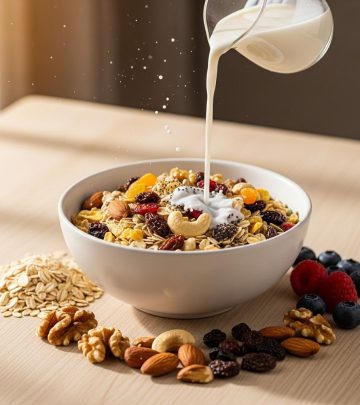Bleached vs. Unbleached Flour: What Every Baker Should Know
Explore the essential differences between bleached and unbleached flour to discover which is right for your next baking adventure.

When you stroll through the baking aisle, the options for all-purpose flour often fall into two categories—bleached and unbleached. Both may look similar on store shelves, but the differences in how they’re processed and how they perform in recipes can have significant impacts on the appearance, taste, and texture of your baked goods. This comprehensive guide examines what distinguishes bleached from unbleached flour, their production processes, how each type affects your favorite recipes, and offers practical tips to help you choose.
The Basics: What Is Flour Bleaching?
Flour starts its life as the inner part (endosperm) of a wheat kernel, which is separated from the bran and germ during milling. However, after milling, the resulting flour is often yellowish, not the pure white most home bakers expect. This is where the distinction between natural aging and chemical bleaching comes in:
- Unbleached flour is allowed to age and whiten naturally over days or weeks through oxidation as it is exposed to air.
- Bleached flour undergoes a chemical treatment with agents such as benzoyl peroxide or chlorine to speed up and intensify this whitening process. This treatment also alters the flour’s texture and baking performance.
How Bleached and Unbleached Flour Are Made
Unbleached Flour
Unbleached flour is simply white flour allowed to oxidize and mature with exposure to air in a controlled environment. This natural aging process generally takes:
- 2-3 weeks in warm climates
- Up to a month in colder seasons
This slow maturation process not only whitens the flour but also strengthens the gluten structure and develops subtle flavors, resulting in a slightly denser texture and a creamy off-white color. Unbleached flour is typically said to have a stronger, more robust flavor and remains slightly harder than its bleached counterpart.
Bleached Flour
Bleached flour, by contrast, is treated with chemicals such as:
- Benzoyl peroxide (commonly used to whiten flour without imparting flavor but may leave traces of benzoic acid)
- Chlorine gas or chlorine dioxide (not only whitens but also changes how flour absorbs water and reacts during baking)
- Potassium bromate (historically used to strengthen dough, now banned in many regions due to health concerns)
Chemical treatments rapidly break down pigments, resulting in a bright white flour that’s finer and lighter. These treatments also chemically ‘age’ the flour, modifying the proteins and making gluten weaker and softer—a quality prized in delicate cakes and pastries.
Why Some Flours Are Bleached and Others Are Not
Historically, commercial bakers and large-scale manufacturers preferred bleached flour for its consistent color, improved rise, and soft crumb. The speed and uniformity of chemical bleaching allowed mills to turn around inventory faster without weeks of storage and aging. For home bakers, bleached flour can be appealing for its affordability and predictable outcome in certain recipes. Unbleached flour, however, appeals to bakers seeking more natural ingredients or specific textural qualities in European-style bread and hearty baked goods.
Comparing Characteristics: Bleached vs. Unbleached Flour
| Aspect | Bleached Flour | Unbleached Flour |
|---|---|---|
| Color | Bright white | Creamy off-white |
| Texture | Finer, softer | Denser, slightly coarser |
| Protein Content | Typically a bit lower | Usually slightly higher |
| Flavor | Neutral, possible chemical notes | More robust, natural wheat flavor |
| Baking Performance | Great for cakes, cookies, pastries that benefit from tenderness | Ideal for breads, rolls, and recipes needing extra chewy structure |
| Processing | Chemically bleached and aged | Air-aged, naturally oxidized |
| Price | Usually less expensive | Often higher due to aging time |
Bleached Flour: Details, Applications, and Pros & Cons
How It’s Made
Chemical agents are introduced immediately after milling to accelerate aging and whitening. This flour is commonly used in mass-produced baked goods for its consistency.
Common Uses
- Cakes (especially angel food and sponge cakes)
- Cookies and bar desserts
- Muffins and quick breads
- Biscuits and soft-crumb pastries
Bleached flour’s fine texture yields tender, soft crumbed results, and the pure white color is desirable in visually delicate desserts.
Pros
- Quick production and lower cost
- Produces lighter, softer baked goods
- Consistent performance in recipes requiring tenderness
Cons
- May have a subtle chemical aftertaste, especially to those sensitive to additives
- Contains fewer natural flavors
- Some consumers are concerned about health impacts of bleaching agents
Unbleached Flour: Details, Applications, and Pros & Cons
How It’s Made
After milling, flour is stored and aged naturally with exposure to air, allowing safe oxidation and color change without chemicals. The process is more time-consuming and slightly costlier.
Common Uses
- Yeast breads, including artisan loaves and sourdough
- Pasta and pizza dough
- Puff pastries, choux (like éclairs and cream puffs)
- Rolls and other hearty baked goods
Unbleached flour’s stronger protein network supports better gluten development, making it preferred for chewy and structured baked goods.
Pros
- Richer, more natural wheat flavor
- No chemical residues
- Better texture and rise in yeast-leavened baked goods
Cons
- Costlier due to lengthy natural aging
- Off-white color can be less desirable in desserts needing bright whiteness
- Slightly denser texture in cakes and cookies
Health and Nutrition: Is One Better Than the Other?
Both flour types—bleached and unbleached—are nutritionally similar, especially if they’re refined all-purpose flour, since both are typically enriched with added B vitamins and iron. However, health-minded bakers may want to consider:
- Bleaching chemicals: Although bleaching agents used in the U.S. are regulated, some people choose to avoid unnecessary food additives.
- Potassium bromate: Once common in commercial bleaching, potassium bromate is now banned in many countries due to its suspected cancer risk. Many reputable brands avoid it entirely.
- The presence or absence of micronutrients is the same; neither type is whole grain unless specified, so you miss out on extra fiber and minerals found in whole wheat flour.
If you are sensitive to food chemicals or want a minimally processed pantry, unbleached flour is usually the more natural option.
When to Use Each: Recipes and Baking Tips
Use Bleached Flour When…
- Color and crumb softness matter most (think angel food cake)
- Baking cookies, pancakes, waffles, or other desserts looking for a tender texture
- Your recipe favors rapid rising with chemical leaveners (baking powder/soda)
Use Unbleached Flour When…
- Baking yeast breads, pizza, or other recipes requiring a stronger gluten network
- Making recipes with long fermentation or rising times (like sourdough)
- Desiring a robust, natural wheat flavor in the final product
Can Bleached and Unbleached Flour Be Used Interchangeably?
Generally, these two flours can be swapped in most recipes with minimal changes in the final result, especially for everyday home baking projects. However:
- For the finest, lightest cakes, use the flour type the recipe recommends
- Bread recipes and artisanal goods may benefit from unbleached flour’s stronger structure
- If texture and appearance are crucial (as in professional or competitive baking), follow specified instructions closely
Special Considerations & Controversies
- Potassium bromate, a bleaching and improving agent, is banned in Canada, Europe, Japan, and recently in California due to potential health risks. Always check labels if you wish to avoid it.
- Bizarre taste or aftertaste in baked products may indicate sensitivity to chemical residues.
- Bakers with a particular affinity for organic, minimally processed ingredients generally choose unbleached flour.
What About Other Types of Flour?
All-purpose isn’t the only flour available:
- Cake flour often comes pre-bleached for optimum softness and absorbing ability.
- Bread flour, usually unbleached, emphasizes protein and structure for rise.
- Whole wheat flour is neither bleached nor unbleached, as it contains wheat bran and germ and is usually air-aged only.
Always check the packaging for details—labels will specify if the flour is bleached or unbleached, and note any additional treatments.
FAQs: Everything You Want to Know About Flour Bleaching
Q: Do bleached and unbleached flour taste different?
A: Slightly. Unbleached flour can have a more pronounced wheat flavor, while some people detect a neutral or mild aftertaste from chemicals in bleached flour.
Q: Can I substitute bleached for unbleached flour in bread recipes?
A: Yes, in most cases, but unbleached flour is preferred for the chewy, robust texture needed in yeast breads.
Q: Is chemical bleaching safe?
A: Current additives are FDA-approved and used within regulated limits, but some, like potassium bromate, have long-term health concerns and are banned in many places.
Q: Is one flour healthier than the other?
A: Nutritionally, they’re almost identical. The main distinction is in processing. To maximize health benefits, choose whole-grain flour.
Q: What’s the best flour for cookies?
A: Bleached flour tends to yield softer, lighter cookies. If you prefer chewier cookies, try unbleached flour instead.
Final Tips for Home Bakers
- If a recipe specifies a flour type, follow it for best results.
- For most family baking, bleached and unbleached all-purpose flour are readily interchangeable.
- For an artisan, European-style crust or extra flavor in bread, opt for unbleached flour.
- If you are sensitive to chemicals or process as a personal value, unbleached flour may best match your needs.
- Whole-wheat and gluten-free flours are alternative options if you are looking for more nutritional value or have dietary restrictions.
Next time you face the bleached vs. unbleached decision, consider the unique properties of each and your baking goals—and don’t hesitate to experiment. Every batch is a new opportunity to find your favorite flour!












